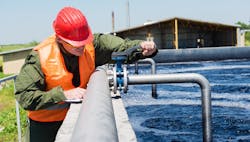Reliability in the drinking water industry
Paul Crocker is a 15-year veteran in maintenance and reliability with specific experience in water treatment systems. He spent almost the last 30 years working for the Kansas City Board of Public Utilities, and recently joined the team at ReliabilityX. Paul recently spoke with Plant Services Editor in Chief Thomas Wilk about the asset management program he helped put into place in Kansas City, as well as how digital technologies are impacting reliability programs in utilities.
PS: What was it about water treatment that persuaded you to build your career in it, as opposed to power?
PC: Well, it was a lot cleaner, at least on the drinking water side. Sometimes you tell people you work in water, and they make the assumption wastewater. It seems it’s like, I never say “waste” in that, but people always assume wastewater, which is a different process and totally different treatment type, and absolutely as necessary as the drinking water side.
To me, the attraction was, that it’s something everybody needs. It’s the one utility that we consume and use for all kinds of things, so it’s important from a public health aspect. People who have clean water generally have better lives all the way around, and they’re not drinking from a creek or a river, or a body of water that’s contaminated by something. So, it’s just important, you know what I mean? It’s like a helper in the public health space, so I always thought it was important to do.
This article is part of our monthly Big Picture Interview column. Read more interviews from our monthly Big Picture series.
PS: What is it about reliability in the drinking water industry that makes it different from something like your average manufacturing plant?
PC: When they design plants and distribution systems, they usually make them with a lot of redundancy and even storage. So, when there’s a storm and your power goes out, well, you don’t have power, but you go to the faucet and you’ve got water, right? So, it could be your whole area is out of power, even the pumping station. Part of that design is why they have elevated towers to give you that extra storage and head pressure at your faucet.
You might not have a pumper pushing it, but you’ve got head in the system, so that redundancy in the equipment really makes a lot of difference, because once you start up a water plant and system, it’s designed to run, and run all the time. So, when you’re repairing it, you’re repairing it while it’s running, so you have the ability to isolate systems and bring on other ones, and nobody at the end can tell any of that whatsoever. That’s a good thing.
Why industrial plant teams need to embrace their creativity to achieve greater success
Why you should automate overall equipment effectiveness data collection
We all meet EPA clean water requirements, which are the highest in the world. Certainly, higher than bottled water, which is FDA standards, but the EPA governs municipal drinking water sources, and the standards are very, very, very high. If we go out of treatment compliance, then you have to report that through a public news agency within a certain amount of time.
Most of us don’t want to have to do that, so we do everything we can to keep the process running and in compliance. The weird thing about reliability is that I’d come back from conferences and start talking about it. And it’s, like, we mean reliable when we run all the time. We really don’t have to shut down for process upsets and stuff like that, so it was a weird transition bringing that stuff back.
I found more value talking about it from an asset management standpoint than just reliability, and just doing maintenance best practices. Because one thing I didn’t like, as a maintenance supervisor at the plants, was equipment failing and not having any heads up about it. So, we put in a lot of condition monitoring practices-oil analysis, vibration analysis, structure-borne ultrasound, infrared, just so we can have a good view as to what’s happening with the equipment, and know ahead of time what’s going to happen.
One thing I like about water is you have friends in all the other water utilities around you, because we don’t compete with each other. Each community has got their own water supply and distribution system, so there’s a lot of working together, and calling my counterpart at a different utility and saying, “Hey, how do you guys deal with this?” Or, they got some new instrumentation and we’re looking at getting that instrumentation, and we go over and look at it.
I know it’s absolutely not the same in manufacturing. People have got their stuff pretty locked down because they don’t want their secrets of how they do it getting out to the competition. That’s something I’ve noticed already.
This story originally appeared in the February 2022 issue of Plant Services. Subscribe to Plant Services here.

